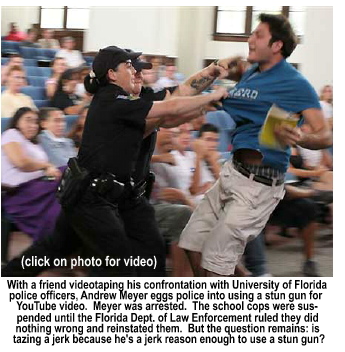
News
Behind the Headlines
Two-Cents Worth
Video of the Week
News Blurbs
Articles
Testimony
Bible Questions
Internet Articles (2015)
Internet Articles (2014)
Internet
Articles (2013)
Internet Articles (2012)
Internet Articles (2011)
Internet Articles (2010)
Internet Articles
(2009)
Internet Articles (2008)
Internet Articles (2007)
Internet Articles (2006)
Internet Articles (2005)
Internet Articles (2004)
Internet Articles (2003)
Internet Articles (2002)
Internet Articles (2001)


Stun guns
are a substitute for deadly force. They
should be used only when the officer's life is threatened.
On Sept. 17, 2007 a University of Florida student named Andrew Meyer (who was described by frequent Fox News guest Michelle Malkin as a "goofball." a celebrity-taunter, and a professional publicity hound) staged own his "assault" by University of Florida police. Malkin reported in her blog that Meyer was accompanied by a woman who was videotaping Meyer's YouTube™ moment-in-history. In hindsight, it now appears Meyer staged a situation that he reasonably had to assume would end the way it did—with him being stun-gunned by University police.
Aside from
the fact that most people have already dismissed the event believing Meyer
got what he asked for, I still find the incident extremely problematic.
I find the tazing of Andrew Meyer troublesome because pulse™
technology conducted-energy weapons (stun guns) are dangerous even if
used properly.  No
police officer anywhere knows the cardiac condition of any person they
accost. In point of fact, few people with cardiac conditions who face
a stun gun welding cop are even aware of their own health risk, and that
their life may be jeopardy if their heart rhythm is interrupted.
No
police officer anywhere knows the cardiac condition of any person they
accost. In point of fact, few people with cardiac conditions who face
a stun gun welding cop are even aware of their own health risk, and that
their life may be jeopardy if their heart rhythm is interrupted.
And, while the cop who fired the burst, or multiple bursts, is excused because he or she followed departmental protocol in using the stun gun, the citizen they accosted for a minor violation is just as dead as if they had taken out their 9mm sidearm and shot him. What that means is that an offense as minor as swearing at a cop or not responding fast enough to an order from a police officer, could become a capital offense. The risk to citizens-at-large is too great for police officers to be allowed to use stun guns for anything less than a life-threatening situation.
Stun guns weren't developed to subdue loud-mouth students in a college forum. Nor to subdue wiseguys who respond too slowly to orders from local police officers. (Common sense suggests that smart-mouthing a cop with a stun gun is first degree stupidity. Most of the idiots who engage in that type of stupidity generally aren't smart enough to see a millisecond into the future and understand what's about to happen to them.) What I find alarming in the hours of video footage I've viewed over the past four years, is how many cops used stun guns out of anger to punish people they were forced to chase on foot—not because the perp swung at them or resisted arrest, but simply because they had to chase them on foot and got winded.
Stun guns are only slightly less dangerous than real guns. In the hands of an angry cop who thinks his "suspect" is still resisting because he's twisting in agony on the ground—and gives him another pulsating burst for good measure—a stun gun can be just as lethal as a gun.
Stun guns became popular with law enforcement agencies as an alternative to the use of deadly force to protect police officers from belligerent suspects with the size and strength to cause personal injury to the cop. In other words the industry leader, Taser™ Corporation designed a law enforcement tool they believed would minimize the risk of lethal consequences in volatile situations where police might otherwise have to use firearms to prevent bodily harm to themselves. In their sales literature, Taser™ viewed the electronic pulse weapon as a lifesaving devise. In fact, they now offer a "citizen" version that women can carry instead of mace or pepper spray to quickly debilitate an attacker. A multiple jolt in the gonads would make any would-be rapist rue puberty.
According to the Taser™ website, their pulse weapons were designed to "...Incapacitate dangerous, combative, or high-risk subjects who pose a risk to law enforcement officers..." and is "...a safer alternative to other uses of force."
But, many of the the police agencies that use them abuse them. Granted, that's not Taser's fault. It's the fault of the cops on the street who use the weapon to punish a perp who made them chase them ten blocks on foot—and made the cop feels like someone stuck their fist down their throat and ripped out their lungs through their nostrils. Stun guns have become the equalizer for secular progressive communities that hire under-qualified females as law enforcement officers when what they should be doing is clerical duty at the precinct. A 5'2" petite cop can't handle a 6'2" burley drunk. Sorry, ladies. That's a fact. But with the equalizer, the petite cop can bring the burley giant to his knees in short order if he doesn't move fast enough or tries to get smart with the cute cop.
Amnesty International has done extensive investigations on the 291 people (between 2001 and September, 2007) who have died after being struck by police stun guns. Most of those who went into cardiac arrest were shocked more than once. Amnesty International records indicate that 92 of those who died were subjected to from 3 to 21 bursts. One man was shocked continuously for 57 seconds. In their report on a Justice Department inquiry last year, Amnesty International said of the 291 deaths, only 25 of the deceased individuals had some form of weapon in their pocket or purse—none of which were a gun. Amnesty International cited the Justice Department's finding that pulse weapons in drive-stun mode were, very often, used as a "pain compliance" device on individuals who were already technically in custody and therefore posed no threat to the law enforcement people. When used in that manner—solely to inflict pain through either multiple or prolonged shock—the stun gun is being used as a torture device.
The Florida Department of Law Enforcement ruling that cleared the University of Florida police officers who were placed on administrative leave following the incident was wrong. They determined that because the officers followed protocol, they did nothing wrong. The problem is the protocol is wrong. Using stun guns on nonviolent, non-threatening citizens is wrong. Amnesty International is correct in its argument that it was wrong to place pulse weapons in the hands of law enforcement agencies before the medical community could weigh the medical consequences of pulse weapons on people with heart conditions, those engaged in substance abuse, or have other factors that compromise their health. The "guinea pig" research done by stun gun manufacturers found that the risk of adverse affects from stun guns on healthy adults was generally low. What that statement means on its face is that there is substantial risk to those with compromised health if there is only "minimal risk" to a healthy adult. The oldest victim of police stun gun abuse was 95. The youngest was a 6-year old truant. Neither posed a physical threat to police. Both were immobilized with an electrical charge.
Since the police can't diagnose the high risk targets at a glance, its basically a crap shoot when they opt to use their pulse weapon to subdue a citizen for whatever reason. Police claim they didn't know that 56-year old Emily Marie Delafield of Green Cove Springs, Florida was a health risk when they arrived at her home on April 24, 2006 to settle a domestic dispute. Delafield wouldn't put down the knife she was holding so cops gave her a jolt with a stun gun. She was rushed to Orange Park Medical Center where she was dead-on-arrival. The two officers who should have known better than to use a stun gun on a visibly imfirmed person, were placed on administrative leave.
On June 12, 2005, when Horace Owen—who was hallucinating while on a cocaine high—broke into the West Park, Florida home of MacArthur Hodges screaming that someone was chasing him and wanted to kill him. Hodges called the Broward County Sheriff's Department and asked for deputies to eject the hysterical man from his house. Deputies, who should have known from their training that pulse weapons can cause electro-muscular disruption in anyone high on drugs, used a stun gun to subdue Owen. He was pronounced dead an hour later at Memorial Regional Hospital in Hollywood, Florida. Owen received what amounted to a death sentence for housebreaking to escape a mythical murderer he thought was chasing him.
Forty-seven year old James Borden was also strung out on drugs. Monroe County, Indiana sheriff's deputies found him wandering around in a drug-stupor and arrested him. At the lockup, Borden resisted efforts by deputies to strip search him. The jailer shot Borden several times with a stun gun before the jailer noticed that Borden was no longer responsive and that his face had lost all color. He was dead. The jailer was charged with two counts of felony battery.
Fort Myers, Florida police were called to subdue a man in the parking lot of the Ruth Cooper Center for behavioral Health Care on Oct. 15, 2005. Forty-five year old Steven Cunningham was arguing with a friend in the parking lot. The friend brought Cunningham to the facility because he was suffering from cocaine toxicity. Where they could have easily subdued him with pepper spray, the Fort Myers police opted to use a stun gun. He was shocked three times. The last time was after Cunningham was shackled and could not harm anyone. He died. He suffered capital punishment for arguing with a friend who wanted him to admit himself into a detox center.
On the same night in Fort Myers 35-year old Tracy Rene Shippey walked into a Hallmark Gold Crown Store on Cleveland Avenue and asked store employees to call 911 because she had been in a fight. Shippey—like Cunningham—was suffering from cocaine toxicity. While employees told police that Shippey knocked over some displays in the store because they didn't respond fast enough, it is more likely that she simply fell into them.
When the police arrived and attempted to take her into custody on the store's complaint, she tried to leave. One officer tackled her, causing her to become agitated. She was shot with a stun gun. She was handcuffed and placed in the backseat of the squad car. When Shippey tried to kick out the back window of the cruiser and she was stunned again several times. (The police have declined to state how many times she was stunned, or for what length of time.) According to police, she began foaming at the mouth and her lips turned blue. Paramedics were called at 7:08 p.m. and arrived 15 minutes later. She was pronounced dead at the Southwest Florida Regional Medical Center shortly after 8 p.m. Her capital offense? Knocking over a store display. The coroner listed the cause of death as "excited delirium."
Excited delirium is not a medical term and does not represent a medical cause of death. She, like Cunningham died from electro-muscular disruption caused by the stun gun and the victim's drug addiction. County coroners, particularly in Florida, use the made-up phrase "excited delirium" to insulate law enforcement from allegations of excessive force and to suggest it was the medical problems of the victim and not excessive force by police that caused their deaths.
Cases like this are so commonplace that we have stopped questioning it when they happen. We need to question authorities who use stun guns because 291 deaths since 2001 suggest that law enforcement officers have literally executed American citizens for "crimes" as minor as yelling in the street. In April, 2005 a Minnesota man died after local police shot him with a stun gun because he refused to stop shouting at his neighbors. A Houston County, Texas man was stunned to death when he refused to pay a $700 fine.
Fortunately, most people who are victims of stun gun abuse don't die. A Riviera Beach, California cop shot a derelict with a stun gun for sleeping on a park bench and for not getting up fast enough when the cop asked for ID. In Palm Beach, Florida police used a stun gun on a man riding a bicycle at night without a headlight. A woman in Boyington Beach, Florida was shot with a stun gun for going 52-mph in a 35-mph zone. Police said she was stunned because when one of the officers pulled her out of her car, she tried to slap him.
Instances of police stun gun abuse are rampant. Sadly, the protocols instruct law enforcement officers how to use stun guns, but not when. Theoretically, cops supposedly understand that stun guns are dangerous weapons that can cause death or serious injury. Logic suggests stun guns, like the cop's 9mm sidearm, will be used only when the officer is threatened with bodily injury. Under no circumstance should a pulse device be used on anyone who appears to be a good prospect for cardiac problems or appears to be stoned on drugs.
Imagine for a moment that you read an article in the morning paper about a cop firing his weapon at an unarmed, fleeing robber—and killing him. You are morally outraged that such a thing could happen. Where is the moral outrage against the cop who kills a man who won't stop yelling at his neighbors? Does it not exist because the cop used a stun gun, and the death is viewed as an unfortunate accident? Is the man who was yelling any less dead because he was shot with a stun gun and not a 9mm Glock?
How does the cop know when he should, or shouldn't, use a stun gun? If he has any street smarts, he knows. If he doesn't have any street smarts, he shouldn't be carrying a gun of any type. If the person the officer is obligated to accost is 50-plus, or overweight at any age, or tries to leap buildings in a single bound, he should use pepper spray if they get belligerent because those people I just described are likely subjects for elecro-muscular disruption. If they are stun-gunned there's a chance it will kill them.
While their eyes might burn for a while, they'll still be alive in the morning. Far too often police use stun guns not to protect the officers from what may appear as superior force, but to mete out corporal punishment to people who do not respond to their orders fast enough. Cities appear to find nothing wrong with this. This contravenes the public perceived national standard of police conduct which mandates police use only that force necessary to protect themselves in the line of duty. The force used should be proportional to the threat posed. A drunk sleeping on a park bench poses no threat. Neither does an elderly man riding a bicycle at night. Or a 95-year old senior citizen—or a 6-year old child who skips school.
We, the people, need to demand that all law enforcement agencies stop using stun guns until comprehensive studies—performed by doctors—have been completed. The medical community, not lawyers, should structure the protocols that advise law enforcement personnel under what circumstances—and on what types of people—they can use pulse weapons. Law enforcement may argue that 291 stun gun deaths in the United States in 6 years—based on the number of people who have been shot with pulse weapons—is astronomically low. That may be. But having the cop on the street sentence an unruly citizen to death for a minor infraction of the law—or for shouting at his neighbors—violates the standard of decency. One such death is one too many. Give the stun guns to the military. Get them off the streets and out of the hands of cops who have come to believe they have a right to use them to prod citizens who move too slow.

Copyright © 2009 Jon Christian Ryter.
All rights reserved.


